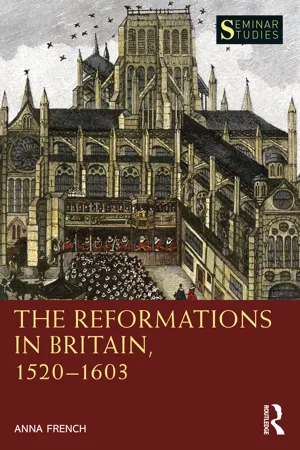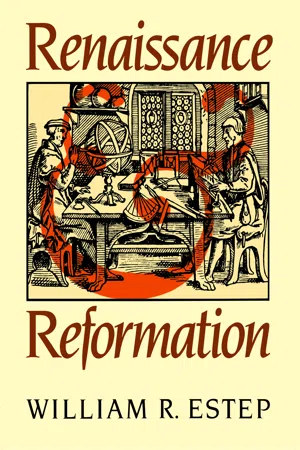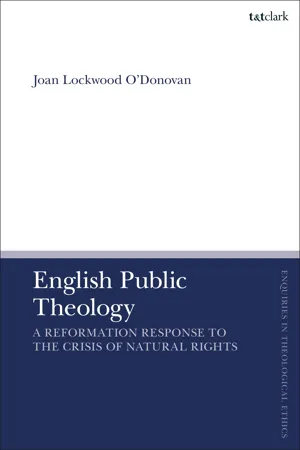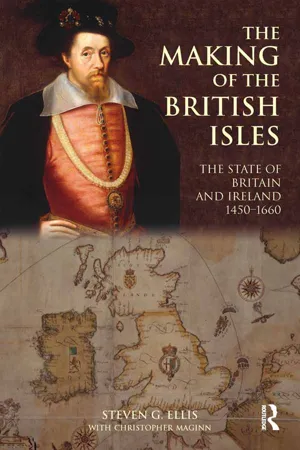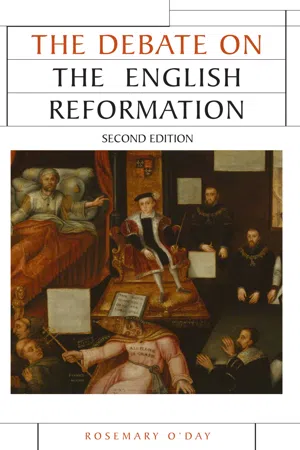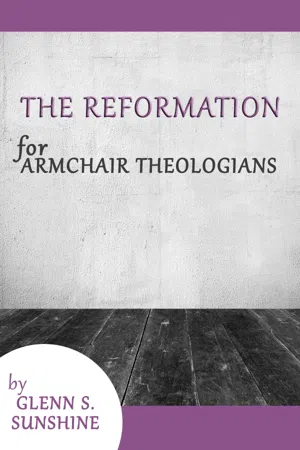History
The English Reformation
The English Reformation was a series of events in the 16th century that led to the Church of England breaking away from the authority of the Pope and the Roman Catholic Church. It was initiated by King Henry VIII's desire to annul his marriage to Catherine of Aragon and was further influenced by religious and political factors, ultimately resulting in significant changes to the religious landscape of England.
Written by Perlego with AI-assistance
Related key terms
10 Key excerpts on "The English Reformation"
- eBook - ePub
- Anna French(Author)
- 2022(Publication Date)
- Routledge(Publisher)
1PoliticsDOI: 10.4324/9781003182283-2The Reformation: Event or Process?
A view of the British reformations as a set of fundamentally political events has proved surprisingly resilient. From the machinations in marriage of Henry VIII to the vexed status of the Auld Alliance between France and Scotland, the middle years of the sixteenth century were certainly an unusually insecure period politically speaking. In England, acute anxiety still surrounded the right of the Tudors to their throne and centred specifically on Henry VIII’s capacity to produce a male heir. In Scotland, meanwhile, two successive monarchs – first James V (1512–1452) and then his daughter, Mary I (1542–1587) – came to the throne while still infants, contributing to an unusually fractious tumult north of the border.This sense of insecurity was fed and was informed by the processes of the British reformations. Certainly the single defining experience of the early modern world was the so-called “confessionalisation”, which split Europe into opposing Christian tribes (76 ): on the one hand, Roman Catholics, who upheld the “old faith” and remained loyal to the Pope and the liturgies of his cardinals, bishops, and priests as well as to ceremony and traditional theology; and on the other hand, the Protestants, who rejected the authority of the Pope, taught simpler forms of worship and prized both the individual’s direct relationship to God and most especially to the Word of God as set down in the Bible. In England and Scotland alike, which would both shift towards the second camp, the most influential Protestant thinker would prove to be not Luther but John Calvin, a Frenchman who was in most ways more radical than his German forebear (1 - eBook - ePub
- John Lawson(Author)
- 2013(Publication Date)
- Routledge(Publisher)
The final stage was the reformation of doctrine; deeply influenced by Calvinism, this started under Edward VI and, after the brief Catholic reaction of Mary’s reign, was accomplished in the early years of Elizabeth’s. The Church of England that emerged preserved intact its ancient episcopal organization and legal structure, but had a new liturgy embracing Catholic and Protestant elements, set out in English in the Prayer Book; and a broad compromise theology summarized in the Thirty-nine articles. In 1559 the Queen was made its ‘Supreme Governor’ by the Supremacy Act; and by the Uniformity Act of the same year all her subjects were obliged under penalty to accept its form of worship and none other. During the greater part of Elizabeth’s reign the overriding concern of the central government was to strengthen this new religious establishment, and protect it from dissentient minorities—Catholics on the one hand, and, to a less extent, radical Calvinist nonconformists on the other. 57 The Reformation and education in England The English Reformation was thus a thoroughly revolutionary movement, but one smoothly and peacefully carried out. It affected not only the religious beliefs and practice of English people, but also the constitution, the social life and economic structure of the country, reacting in ways which cannot be defined precisely with other developments that were simultaneously changing society. A fast growing population and consequent inflation were the concomitants of Reformation, and in their effects on education were perhaps in the long run of even greater significance. The decline in the territorial power of the Church was also accompanied by the rise of a new class of landed gentry, many of them with a stake in former monastic and chantry estates, who came to control policy and government as Members of Parliament and justices of the peace - eBook - ePub
- William R. Estep(Author)
- 1986(Publication Date)
- Eerdmans(Publisher)
Chapter XIVTHE REFORMATION COMES TO ENGLAND
T he Act of Supremacy passed by the English Parliament in 1534 separated the Church of England from Rome and made the king of England the head of the church. Thus Henry VIII (1491–1547), proclaimed “Defender of the Faith” by Pope Leo X for his polemical tract against Luther, became the defector of the faith. Some sympathetic historians have held that the Reformation in England was launched because of the amorous English monarch’s desire to be free from Catherine, his aging spouse. But the truth of the matter is far more complicated than Henry’s marital problems. While there is no denying that Henry VIII became infatuated with Anne Boleyn, a spirited young lady who wanted very much to be Henry’s wife and England’s queen, it is inaccurate to claim that Henry’s adulterous affair caused a reformation of the English church. Such an observation is superficial if not malicious. If it hadn’t been for extenuating circumstances and the support of loyal and capable men such as Thomas Cromwell and Thomas Cranmer, Henry’s divorce from Catherine could have provoked a civil war, not a reformation. In the final analysis it produced not The English Reformation but only an opportunity for reform. The shape of the Reformation in England, therefore, was largely the result of a set of circumstances that had come to prevail in the island kingdom.REFORMATION BEFORE 1534Lollardy, the movement that owed its origin to the work of John Wycliffe, had not completely died out when the Reformation began to take root in English soil. Two distinctive emphases seem to have been basic to the movement from its inception: the authority of Scripture and the priority of preaching. These emphases were also dear to the Reformers; in fact, as A. G. Dickens suggests, “Perhaps the only major doctrine of the sixteenth century Reformers which Wycliffe cannot be said to have anticipated was that of Justification by Faith Alone.”1 The Lollards had much in common with other medieval anticlerical parties. They sowed the seeds of distrust and skepticism that were largely responsible for the anticlericalism of the fifteenth century. They often expressed their ideas crudely, but their meaning was unmistakable. Their list of grievances included the ringing of church bells, relic worship, the use of images in worship, transubstantiation, purgatory, pilgrimages, indulgences (which they viewed as “payment for the forgiveness of sins”),2 - eBook - ePub
English Public Theology
A Reformation Response to the Crisis of Natural Rights
- Joan Lockwood O'Donovan(Author)
- 2023(Publication Date)
- T&T Clark(Publisher)
Chapter 2 THE REFORMATION TRADITION IN CRISIS The English Reformation tradition of public theology, as a tradition of both political and ecclesiastical thought and practice, was central to English Christian society for over four centuries. Although its political, legal, liturgical, and doctrinal components were never entirely free of controversy and dissent, calling forth pastoral and juridical responses of accommodation and restraint, the unifying force of this tradition was, nevertheless, discernible within England’s ecclesiastical and civil polity. However, the last seventy years have seen an unprecedented disengagement from this inheritance in the Church of England’s worship and doctrine and in its political framework and setting. In the church’s worship and doctrine, abandonment of the use of the 1662 Book of Common Prayer and Ordinal has been pivotal to this disengagement. In that the 1662 prayer book’s use was (and is still) required by parliamentary law, 1 that it enshrined the King James Version of 1611 in Bible readings 2 and was regularly published under one cover with the Thirty-Nine Articles of Religion, it gathered the biblical, liturgical, doctrinal, and political strands of The English Reformation’s public legacy and conveyed the legacy’s coherence. Thus, the Church of England’s detachment from the 1662 prayer book has been accompanied by detachment from the translation tradition of the King James Version and from the pedagogical and disciplinary roles of the Thirty-Nine Articles of Religion - eBook - ePub
Western Civilization: A Global and Comparative Approach
Volume I: To 1715
- Kenneth L. Campbell(Author)
- 2014(Publication Date)
- Routledge(Publisher)
The Protestant and Catholic reformationsIn early modern Europe, every Christian from princes to paupers viewed religion as central to their thoughts and experiences, partly because their faith emphasized that each Christian had the duty to love others and partly because of the power and control exercised by the institutional church. Most people, including Jews and Muslims, believed in God and God’s ultimate control over life and death. Many Christians believed that saints could and did aid them in successfully completing their daily tasks, in preserving them from danger, or in helping them to convalesce after an accident or illness. Religious images and symbols confronted people everywhere they went. Yet even in the Middle Ages, the potential for division among Christians existed, despite the church’s concerns with preserving a level of conformity and extirpating heresy by whatever means necessary. The social and economic changes of the late medieval world prepared the way for the acceptance of new ideas, new attitudes toward the church, and new institutional realities.The Reformation of the sixteenth century was a religious movement that challenged the abuses, practices, and certain doctrines of the established church. It also promoted the search for a more personal faith in the context of a reformed church believed to coincide more closely with that of the first Christians. Early reformers such as Martin Luther, Huldrych Zwingli, and John Calvin concluded that the church failed to provide meaning to their personal understanding of Christianity. Many Europeans proved open to reform ideas and would reject Catholicism for a reformed faith that offered a different path to God and a different interpretation of the Christian experience. The Reformation ended up creating a complex legacy that divided Europe into rival religious camps, leading to a further intertwining of politics and religion and more than a century of religious strife and warfare. - eBook - ePub
Please Don't Wish Me a Merry Christmas
A Critical History of the Separation of Church and State
- Stephen M. Feldman(Author)
- 1998(Publication Date)
- NYU Press(Publisher)
C HAPTER 5 The English Reformation, Civil War, and Revolution During the sixteenth and seventeenth centuries, England underwent a remarkable transformation as it passed through the Henrician Reformation, the Elizabethan Settlement, the Civil War, the Restoration of the monarchy, and finally the Glorious Revolution. 1 The causes of some of these events remain notoriously ambiguous. Different historians, for example, have attributed the Civil War of the 1640s either to religious, political, economic, or even geographical factors. 2 Those who emphasize religion tend to refer to this period as the Puritan Revolution, 3 while others insist that there was no revolution at all, Puritan or otherwise. 4 Recent scholarship tends to emphasize a multitude of causal factors. Conrad Russell, for instance, argues that three long-term causes of instability simultaneously came to a head, thus sparking the Civil War. In Russell’s words, the factors were “the problem of multiple kingdoms, the problem of religious division, and the breakdown of a financial and political system in the face of inflation and the rising cost of war.” 5 Nevertheless, because I am concerned with the development of church and state, I will discuss primarily the importance of religious and political factors in the English Civil War, as well as in the other major events of the sixteenth and seventeenth centuries. Indeed, the conjunction of political and religious strife in England during these two centuries, perhaps more so than any other single consideration, has shaped the current understanding of the separation of church and state in American constitutional thought - eBook - ePub
The Making of the British Isles
The State of Britain and Ireland, 1450-1660
- Steven G. Ellis, Christopher Maginn(Authors)
- 2014(Publication Date)
- Routledge(Publisher)
3 Yet these movements were firmly under the church's control. The onset of the Reformation raised a series of new ques- [123] tions. Princes could not avoid taking a stand on matters of religion, and generally it was their preferences which determined whether the territories they ruled remained Catholic or became Protestant. The two British monarchies eventually opted for Protestant settlements, with the further result that Protestantism became an important element in both English and Scottish identities, and eventually in senses of Britishness. Nonetheless, this was a hard-fought issue, both because individual monarchs had different preferences in regard to religious change, but also because their choices were contested by many of their subjects, so giving rise to the problem of religious minorities.Even though the Tudor and Stewart monarchies both eventually accepted and enforced broadly Calvinist forms of Protestantism within their territories, there were considerable differences in the methods by which these, in many respects, very similar religious settlements were achieved. For one thing, the onset of the Tudor Reformation occurred almost 30 years before its Scottish equivalent, and central to its origins were Tudor dynastic needs. But for Henry VIII's desire for a son and heir, it is doubtful whether this ‘defender of the faith’ and leading critic of Martin Luther would have broken with Rome, particularly since for almost 20 years Henry's diplomatic ambitions had usually accorded with those of the papacy. Thereafter, for the rest of Henry VIII's reign, the royal supremacy constituted one of the few fundamental departures from late medieval Christianity. And even with the introduction under Edward VI and Elizabeth I of a Protestant religious settlement along continental European lines, the supremacy remained one of the most distinctive features of what later came to be called Anglicanism.The Henrician Reformation
In the first phase of the Tudor Reformation, to the accession of Queen Elizabeth, the emphasis was firmly fixed on change at the centre, the statutory enactment of religious change. This phase of state-sponsored reform reflected overwhelmingly the power of the Tudor state but it also saw a vast extension of this power over the lives of ordinary subjects. Accordingly, the first part of this chapter offers a sketch of the nature of these changes. Broadly, the religious settlement under Henry VIII remained much closer to traditional pre-Reformation Christianity than to the practices of the leading continental reformers. The initial steps towards Tudor reform were geared chiefly to bringing the church in England more securely under royal control for the purpose of securing the royal divorce. - eBook - ePub
The Debate on the English Reformation
Second edition
- Rosemary O'Day(Author)
- 2015(Publication Date)
- Manchester University Press(Publisher)
Clearly, the institutional machinery of the Church and the personnel of that Church simply were not geared to perpetrate a wholesale reformation before the middle of Elizabeth’s reign. Reformation took root early in some places. The cause of the Reformation was not yet won. England might be described as Protestant in that she had protested against the pope’s authority and had sloughed it off, but doctrinally she remained predominantly Catholic. To this generation of historians the geographical spread of Protestantism seemed, then, to have been slow until Elizabeth’s reign. To say that the headway it did make was insignificant was for some, however, to say too much, for there appeared sufficient evidence to show that Protestantism was early gaining strength among the influential. Kent, after all, was by sixteenth-century standards a densely and highly populated county. The new religion seems to have spread quite early and easily in the towns of the kingdom. 56 It also took hold at the universities. If the leading intellectuals and gentry who favoured the new religion were sent into exile and were therefore unable to influence directly the evangelization of Marian England, they did, as it turned out, ensure the future of English Protestantism by keeping the flame of the new religion ablaze. 57 And it was surely important that there were some Protestant congregations within England itself upon which the Elizabethan Church could build. What were the factors which hastened the advance of Protestantism or hindered it? In an early essay, David Palliser discussed this question. 58 Here Palliser drew a picture of a South and East broadly receptive to Protestantism during the crucial years down to 1570 and a North and West less so. But he sought to refine this ‘crude textbook picture’ - eBook - ePub
- Glenn S. Sunshine(Author)
- 2005(Publication Date)
- Westminster John Knox Press(Publisher)
CHAPTER ELEVEN The Reformation in England and ScotlandLike so much else in British history, the English and Scottish Reformations interacted with events on the Continent but really developed with an internal logic all their own. To understand the way the Reformation played out, we need to start with late-fifteenth and early-sixteenth-century dynastic politics.Spain and EnglandDuring the late fifteenth century, the territory that would become Spain was divided up into a number of territories. The two most important were Aragon, led by its king Ferdinand, and Castile, led by its queen Isabella. Each of these kingdoms owned other territories outside of Iberia, but for our purposes in this chapter that is not terribly important. Ferdinand and Isabella decided to marry and to pass down a united kingdom to their heir. This happened to be their grandson, Charles I/V Habsburg, whom we discussed earlier. In addition to Joan the Mad, Charles’s mother, Ferdinand and Isabella had another daughter, Catherine of Aragon.With the end of the Wars of the Roses, Henry VII Tudor came to the throne of England. Spain was emerging as a great power and rival on the continent to France. Since England and France also had a longstanding rivalry, it made sense for England to set up an alliance with Spain. So, following the normal diplomatic procedures of the day, they arranged a marriage between Catherine of Aragon and Arthur, Henry VII’s oldest son. Arthur, however, died shortly after the marriage. This left England and Spain in a bit of a bind; all the reasons for having the marriage were still in place, but it was illegal for Henry VII’s second son, also named Henry, to marry Catherine since she was his brother’s widow. Catherine, however, swore that the marriage had never been consummated, so that gave Henry VII a loophole, though canon law still said the marriage to Arthur was binding. But being king gives you clout in high places, and so the pope gave Henry special dispensation to marry Catherine. Meanwhile, Henry VII died, leaving Henry VIII on the English throne. - eBook - ePub
- Glenn S. Sunshine(Author)
- 2017(Publication Date)
- Westminster John Knox Press(Publisher)
Chapter Eleven The Reformation in England and ScotlandL ike so much else in British history, the English and Scottish Reformations interacted with events on the Continent but really developed with an internal logic all their own. To understand the way the Reformation played out, we need to start with late-fifteenth and early-sixteenth-century dynastic politics.Spain and EnglandDuring the late fifteenth century, the territory that would become Spain was divided up into a number of territories. The two most important were Aragon, led by its king Ferdinand, and Castile, led by its queen Isabella. Each of these kingdoms owned other territories outside of Iberia, but for our purposes in this chapter that is not terribly important. Ferdinand and Isabella decided to marry and to pass down a united kingdom to their heir. This happened to be their grandson, Charles V Habsburg, whom we discussed in chapter 2 . In addition to Joan the Mad, Charles’s mother, Ferdinand and Isabella had another daughter, Catherine of Aragon.With the end of the Wars of the Roses, Henry VII Tudor came to the throne of England. Spain was emerging as a great power and rival on the continent to France. Since England and France also had a longstanding rivalry, it made sense for England to set up an alliance with Spain. So, following the normal diplomatic procedures of the day, they arranged a marriage between Catherine of Aragon and Arthur, Henry VII’s oldest son. Arthur, however, died shortly after the marriage. This left England and Spain in a bit of a bind; all the reasons for having the marriage were still in place, but it was illegal for Henry VII’s second son, also named Henry, to marry Catherine since she was his brother’s widow. Catherine, however, swore that the marriage had never been consummated, so that gave Henry VII a loophole, though canon law still said the marriage to Arthur was binding. But being king gives you clout in high places, and so the pope gave Henry special dispensation to marry Catherine. Meanwhile, Henry VII died, leaving Henry VIII on the English throne.
Learn about this page
Index pages curate the most relevant extracts from our library of academic textbooks. They’ve been created using an in-house natural language model (NLM), each adding context and meaning to key research topics.
